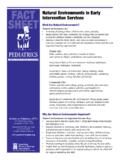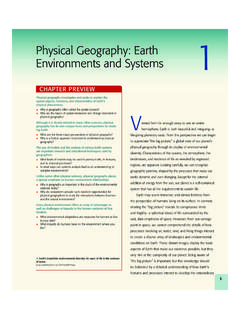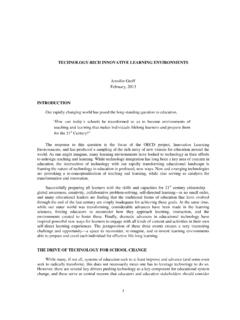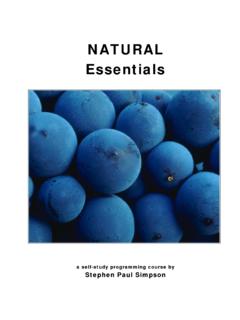Transcription of The Natural Environment as a Playground for Children: The ...
1 Early Childhood Education Journal, , ,Winter 2001( 2001)Environmental EducationThe Natural Environment as a Playground for Children: The Impact of Outdoor Play Activities in Pre-PrimarySchool ChildrenIngunn Fj rtoft1 INTRODUCTION have experienced positive results from being outdoorsin Natural environments, but only a few studies haveNorwegian studies have revealed a disquieting ten-been done in this field (Bang et al., 1989; Fj rtoft, 1999;dency that children are becoming more sedentary inGrahn et al., 1997). We know far too little about howtheir adolescence. They spend more time, approximatelythe Natural Environment functions as a Playground forthree hours a day, on TV, video, and electronic mediachildren, and we know even less about what effects such(MMI, 1995).
2 The movement pattern of children hasa Playground might have on learning in children. Thechanged remarkably the last 10 20 years. The unorgani-physical outdoor Environment , and the Natural environ-sed traditional games, which included lots of movingment in particular, as a play habitat for children, hasaround, are now changing into sitting in front of yourbeen a topic of low priority in child research (Bjerke,private computer playing computer games. Such scenar-1994).ios have resulted in several health hazards like increas-ing obesity in early childhood (Anderson et al., 1998),THE AFFORDANCE OF NATUREand motor problems in children are reported in severalScandinavian studies (Due et al.)
3 , 1991; Hertzberg, 1985; Natural environments represent dynamic and roughGilberg and Rasmussen, 1982; Kjos, 1992; Ropeid,playscapes that challenge motor activity in children. The1997). However, a recent study of the physical activitytopography, like slopes and rocks, afford Natural obsta-among 3 7 years old Norwegian children (MMI, 1997)cles that children have to cope with. The vegetation pro-showed that 75% of the children spend some time out-vides shelters and trees for climbing. The meadows aredoors by their own every day. The most active onesfor running and tumbling. Description of physical envi-practiced several outdoor activities such as skiing andronments usually focuses almost exclusively on in the wilderness, climbing trees, enjoying waterHeft (1988) suggested an alternative approach to de-activities, and soccer in the field.
4 Four out of ten chil-scribe the Environment , which focused onfunctiondren expressed a wish for more time for physical activityrather than form. The functional approach corresponds(Hansen, 1999), but children complain about the lack ofbetter to the children s relations to their arenas for play and free time activities, such asIntuitively children use their Environment for physicalgrounds for climbing, building dens, sliding, and skiingchallenges and play; they perceive the functions of the(Mjaavatn, 1999). Francis (1988) argued that children slandscape and use them for play. The central conceptplay in an unstructured Environment , preferably a natu-guiding children s examination of their Environment isral one, gives the children a genuine understanding ofthat ofaffordance.
5 Gibson (1979) developed the conceptreality. Rivkin (1990, 1995) highlights the values of out- affordance to describe an awareness of the environ-door play, but regrets that children s access to outdoorments and their functional significance, or their func-play habitats are meaning. For example if a rock is big enough toSeveral kindergartens in the Scandinavian countriesfit the hand, it might be perceived as an object to graspor to throw; it affords grasping or throwing. A tree thatis appropriately branched and stemmed, will likewise be1 Address correspondence to Ingunn Fj rtoft, Tel.:+47 35026333, Fax:perceived as climb-on-able; it affords climbing-on.
6 Na-+47 35026201; e-mail: Telemark UniversityCollege, Department of Teacher Training, 3679 Notodden, provides an Environment with such possibilities and1111082-3301/01/1200-0111$ 2001 Human Sciences Press, rtoft112affordances. Frost (1992) introduced the concept play-might be characterized as quasi-experimental approach(Robson, 1993, Thomas & Nelson, 1985). The groupsscape to describe different play environments. He ar-gued that Natural features are important qualities of play-were selected from three kindergartens equal in agegroups. The experimental group of 46 children from onegrounds, and that the Natural features allow a wide rangeof learning opportunities not available from other play-kindergarten was offered free play and versatile activi-ties in the forest next to the kindergarten.
7 The experi-ground options. Hart (1979) and Moore (1986) have de-scribed the children s preferences of wilderness and un-mental group used the forest every day for 1 2 hoursthroughout the year when they attended the landscapes for Scandinavia it has become popular for kinder-Only randomly they used the outdoor Playground insidethe kindergarten fence. As reference group 29 childrengartners to spend more time outdoors in the Natural envi-ronment. Some kindergartens are organized as outdoorof the same age groups from two kindergartens in theneighbouring district were chosen. The groups wereschools, where the children, aged three to six, spend allor most of the day outdoors in a Natural out for differences in socioeconomic living con-ditions by multiple regression analysis, using parents ed-Playing in a Natural Environment seems to have positiveeffects on children; they become more creative in theirucational and professional background as variables.
8 Thereference group used their traditional outdoor playgroundplay, and play activities and play forms are is also indicated that absence due to sicknesses isfor 1 2 hours a day and visited Natural sites only occa-sionally. Both groups had the same standard playgroundlower among children in outdoor kindergartens than inthe traditional ones (Grahn et al., 1997, So derstro m,equipment, such as sandpit, a swing, a seesaw, a slideand a climbing house in their outdoor play ground. The1998). Not the least it is evident that the children s mo-tor fitness is improved. They move easily around in astudy started with a pretest in September.
9 The treatmentperiod lasted for nine months, and was terminated with arugged terrain and cope with physical challenges, whichimprove their motor ability (Fj rtoft, 1999, Grahn et al.,posttest in June the following groups were tested with theEUROFIT: Eu-1997). Although few in number, these studies indicatethat the Natural Environment is a stimulating arena forropen Test of Physical Fitness,the Motor Fitness Test(Adam et al., 1988). The test included the following testlearning in general, and for motor fitness training in par-ticular. The present research corroborates the main find-items: Flamingo balance test (standing on one foot) fortesting of general balance, Plate tapping (rapid two plates alternatively with preferred hand) measur-ing the speed of limb movement.
10 Sit and reach ex-VERSATILE PLAY IN THE Natural pressed flexibility in knee and thigh joints. StandingENVIRONMENT AND THE IMPACT ONbroad jump ( jumping for distance from a standing start)CHILDREN S MOTOR DEVELOPMENT measured explosive strength. Sit-ups (maximum num-bers of sit-ups achievable in half a minute) measuredObjectivestrunk strength. Bent arm hang (maintaining a bent armposition while hanging from a bar) for testing of func-The notion that versatile play in a Natural environ-tional strength in arm and shoulder, and Shuttle run (ament might have an impact on children s developmentrunning and turning, shuttle, test at maximum speed)constituted the background for the present study.







